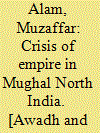|
|
|
Sort Order |
|
|
|
Items / Page
|
|
|
|
|
|
|
| Srl | Item |
| 1 |
ID:
046992


|
|
|
|
|
| Publication |
New Delhi, Oxford University Press, 1986.
|
| Description |
xv, 365p.pbk
|
| Standard Number |
0195630009
|
|
|
|
|
|
|
|
|
|
|
|
Copies: C:1/I:0,R:0,Q:0
Circulation
| Accession# | Call# | Current Location | Status | Policy | Location |
| 044576 | 954.025/ALA 044576 | Main | On Shelf | General | |
|
|
|
|
| 2 |
ID:
160159


|
|
|
|
|
| Summary/Abstract |
The Bengali bhadralok have had an important impact on Indian nationalism in Bengal and in India more broadly. Their commitment to narratives of national progress has been noted. However, little attention has been given to how ‘earthly paradise’, ‘garden of delights’, and related ideas of refinement and nobility also informed their nationalism. This article excavates the idea of earthly paradise as it is portrayed in Satyajit Ray's 1958 Bengali film Jalsaghar, usually translated as The Music Room. Jalsaghar is typically taken to depict, broadly, the decadence and decline of aristocratic ‘feudal’ landowners (zamindars) who were granted their holdings and, often, noble rank, such as ‘Lord’ or ‘Raja’, during Mughal or British times, representing the languid past of the nobility, and the ascendance of a restless business-oriented class that represents an emerging present and possible future. The zamindars are shown as pursuing aesthetic and spiritual delight, ecstasy, and edification through soirées. These soirées are produced for those among the nobility who are sufficiently cultivated and cosmopolitan to appreciate the finer things in life, such as the classical music and dance showcased in this film. The businessmen, too, aspire to host such exceptional events, but are too crass to do so properly and, moreover, they are motivated by a desire to accrue prestige, thus using soirées as a means to an end, rather than to experience aesthetic and spiritual elevation as an end in itself. I argue that the film calls on the bhadralok to value aesthetic cultivation and to actively counter its evanescence. The film thus beckons and authorizes the bhadralok to sustain the value of the timeless past, including nobility and refinement. Yet the bhadralok are also expected to embody and expand a new, progressive, and utilitarian spirit that would modernize India. With the aristocrats gone, and the entrepreneurs eager to assume authority, the film charges the bhadralok to construct a nationalism in which the immortal, character-building values of classical art, for example, can yet be sutured to utilitarian progressivism. I argue that the film conveys this even though it does not explicitly portray or even mention the bhadralok, or feature uniquely Bengali music and art. Accordingly, this article does not focus on the actual aesthetic and political practices of bhadralok nationalism. The aim is to shed light on one genealogy through which the bhadralok sanctioned themselves as India's stewards along these lines.
|
|
|
|
|
|
|
|
|
|
|
|
|
|
|
|
|
|
|
|
|